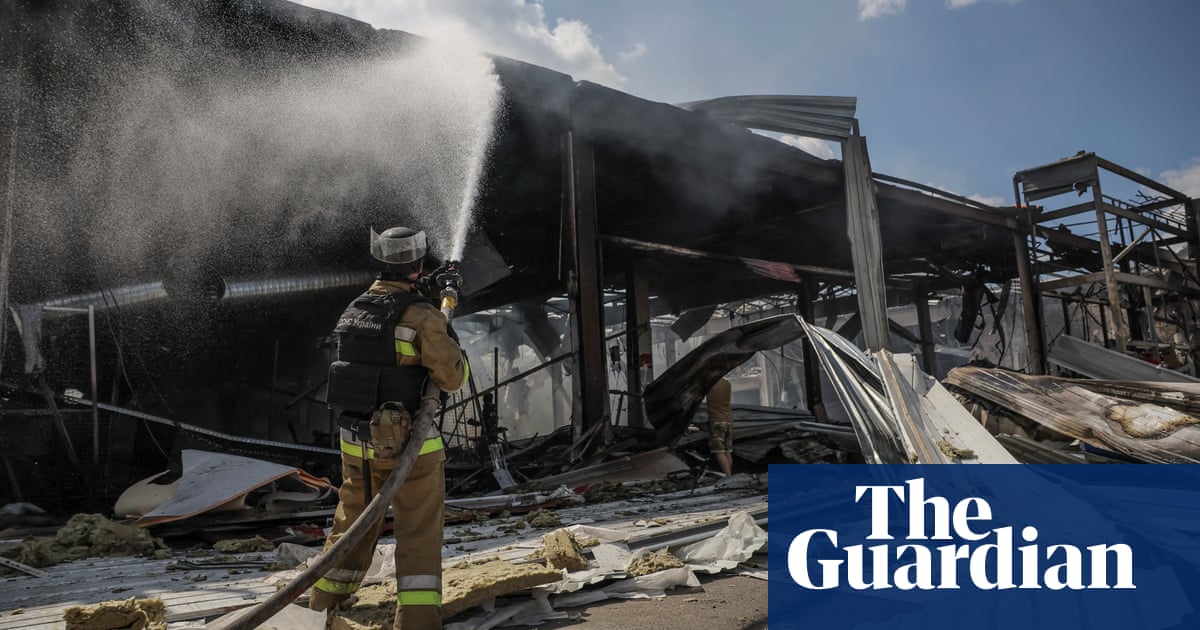Ukrainian forces staged an overnight ambush on a Russian convoy 25 miles inside the international border in Kursk province, as the Kremlin declared a federal emergency and said it was transferring extra forces to try to snuff out a four day old incursion that has badly damaged its credibility.
A video circulated by Russian military bloggers showed a destroyed convoy, with bodies just visible inside some trucks, on the E38 east-west highway at Oktyabrskoe, a location far deeper inside Russia than any previously confirmed fighting since Ukraine’s forces crossed the border on Tuesday.
Commentators said the attack, reminiscent of Ukrainian attacks on Russian troops besieging Kyiv in the first weeks of the war, demonstrated an effective hit and run strategy – but the incursion appeared set to draw an escalating response from the Kremlin and its overall outcome remains profoundly uncertain.
Russia’s defence ministry said at lunchtime that it was transferring military reserves to the Kursk region, according to the Interfax news agency, including Grad rockets, artillery and tanks – while a video released by Zvezda, official Russian military media, showed a convoy of lorries carrying armoured vehicles down a highway.
Alexei Smirnov, the acting governor of Kursk oblast, said Moscow had declared a state of federal emergency in the morning and he urged residents to “stay calm and keep up your fighting spirit, support each other, do not give in to panic and despondency”. So far 3,000 Russian civilians have been evacuated away from the fighting.
Elsewhere, 10 Ukrainians were reported killed and 35 injured after a Russian missile struck a supermarket during the day in Kostiantynivka, about 8 miles from the eastern frontline in Donetsk. “Russian terrorists hit an ordinary supermarket and a post office. There are people under the rubble,” president Volodymyr Zelenskiy said.
Ukraine was able to burst through a lightly defended Kursk border on Tuesday morning, with several hundred troops, according to Russia. Surpassing the defences, Ukraine’s forces have engaged in fast moving manoeuvre warfare, a type of combat that has rarely been seen during the war in Ukraine, which has been largely dominated by fortified trenches and heavy mining, preventing breakthroughs.
The fast moving fighting and limited sources of information means that it is hard to be sure where the front lines are in the sector. Unlike during last year’s failed summer counter offensive, Ukraine’s military has not released triumphant videos of the capture of small villages that give clues to the enemy.
Russia’s semi-independent military bloggers, the principal source of information about the incursion, say that Ukraine has captured the west of Sudzha, 10km from the border, and pushed up three roads to the north east, north and north west of the town, including where a railway and likely supply route runs to the Russian city of Belgorod in the east.
Rybar, a Russian military blogger, said that Ukraine’s tactics are to use its armoured vehicles to head towards Russian positions – and use “a third of them” to tie down the defenders while the rest are “bypassing it, entering nearby settlements and setting up ambushes”. As a result Kyiv’s control of the territory in which it was operating in was limited, the blogger and commentator said.
Ukraine’s leaders have largely avoided commenting on the attack, the first time the country’s regular armed forces have broken through the international border, though on Thursday night president Zelenskiy alluded to developments.
“Russia brought the war to our land and should feel what it has done,” he said in his nightly address. But Ukraine’s intentions remain unclear as the battle develops.
Hanna Shelest, a senior fellow with Center for European Policy Analysis, said that Ukraine had regained some of the initiative with the surprise attack and that it had “a psychological effect in that it has weakened the image of Vladimir Putin as a strong-man president who protects his own people”.
Kyiv’s likely military hope, Shelest added, is likely to be that “Russian reserves would be moved to make Ukraine’s situation in the east easier,” though she acknowledged there had not been any confirmed movement of troops from the Donbas, where Russia’s larger army has been making slow but steady gains for weeks.
John Foreman, a former UK defence attache to Moscow and Kyiv, said he believed the Kursk operation was “not without strategic risk” because it could also divert scarcer Ukrainian resources from already lengthy front lines. “We don’t know the Ukrainian units involved, their strength, logistics, or combat and aviation support. Zooming out territorial gains are so far modest,” he added.
Attacks inside Russia had been considered politically fraught for Ukraine. Its western allies, led by the US have refused to allow high valued western weapons to be used to strike into Russia’s internationally recognised borders for fear of wider escalation. However, this week the White House has been relatively supportive, which Shelest said would be a relief to Ukraine’s leaders.
In April, the US publicly criticised Ukraine for targeting Russian oil refineries, fearing the impact on energy prices and inflation. But on Thursday, Sabrina Singh, the press secretary for the Pentagon, said Ukraine’s incursion into Russia was “consistent with our policy,” though it also remained the case that “we don’t support long range attacks” into Russia. Singh refused to define what was meant by long-range.

